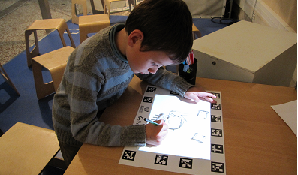Section: Overall Objectives
Introduction
The overall objective of Potioc is to open 3D digital worlds to everyone with the ultimate goal of stimulating creation, communication, understanding, or entertainment. To this end, we propose to focus on the design, development and evaluation of 3D User Interfaces (UI), mostly targeted at the general public. In other words, we aim at designing popular 3D interfaces.
|
Printing, photography, Internet, are examples of technologies that have changed the way people communicate together, understand, create, or get entertainment. At the beginning, these technologies were dedicated to expert users, then they have become available to all, contributing to the fulfillment of everyone. Today, 3D digital worlds could play a similar role, but they tend to be fully exploited only by a limited number of highly trained people. Our motivation is to democratize such 3D technologies for favoring communication, understanding, creation, or entertainment for everyone.
For example, in the scope of learning, it can be difficult for a child to understand how molecules can be assembled together from a drawing on a piece of paper, as classically done in school. We can presume that, with a 3D visualization of the molecules, the understanding of the data can be improved. Beyond a 3D visualization, it will be particularly important for the child to manipulate the molecules to understand how they fit together. Indeed, perception and action are extremely linked, as it has been shown by Berthoz. By being active in the process of interactive visualization, the implication of the child will be increased and, consequently, the learning process will be favored. Such an example requires the completion of complex interaction tasks for which there is no standard solution. Numerous research questions are thus linked to such a challenge, and this is what we want to address in Potioc.
To reach this goal, we focus on the interaction aspect, which we consider as the main barrier for increasing the adoption of 3D digital worlds by all. Indeed, without a proper interface, users would not be able or would not want to use 3D digital worlds. We address 3D interaction tasks such as navigation in 3D environments, manipulation of 3D objects, exploration of volumes, etc. The conception of relevant user interfaces for completing such tasks implies tackling at the same time motor, perceptive, and cognitive aspects, at different levels: hardware, software, and at the user level. In Potioc, we follow a multi-disciplinary approach where our research and development works are arranged according to the following three main axes:
We do not focus on one specific technology. Instead, we take advantage of the wide input and output space that is available today, with a special interest for emerging technologies. In particular, we consider both technologies that are able to detect motor activities, i.e., physical actions of the user (e.g., joysticks, multitouch surfaces and 3D spatial technologies) and interfaces measuring and interpreting the physiological signals of the user, i.e., non-motor activities of the user. This notably includes Brain-Computer Interfaces (BCI), which provide a unique way to access the users' mental states, thus opening the door to many promising applications and tools that tap into this new kind of input, unavailable to other interfaces. We also explore various output spaces, including large-scale visualization, stereoscopic visualization, or tangible approaches.
Based on this rich interaction space, we design interaction techniques dedicated to the completion of 3D interaction tasks. In this project part, we put aside hardware considerations to concentrate on the software part of the UIs. Such interaction techniques target users that are not expert in 3D interaction. In particular, our target users are the general public, specialists with no expertize in 3D, and people with impairments.
Finally, a large part of the project is dedicated to human factors for understanding and for evaluating user interaction. In particular, we conduct experiments a-priori to guide our developments and a-posteriori to assess them. We also explore passive BCI to better evaluate 3D interaction.
Previous research works on 3D UI tended to be driven by criteria of speed, efficiency or precision for industrial purposes. These criteria, which are very important in domains where profitability is crucial, may not be the most fundamental ones in our project where the approach is to increase the intrinsic motivation of non-expert users. Therefore, in Potioc, we will emphasize criteria such as appeal and enjoyment, which have been scarcely taken into account in the past. Indeed, we believe that non-expert users need pleasant and enjoyable interfaces to adopt 3D digital worlds, in the scope of education, art, assistive technologies, or entertainment.
A 3D digital world can be defined as a 3D data space with which one can interact in real-time, the display of such data being either monoscopic or stereoscopic. For instance, a city that has been modeled in 3D, in which a user can navigate using a joystick is a 3D digital world. On the contrary, a 3D movie for which the user remains a passive viewer does not belong to this category.
Brain-Computer Interface are devices that enable its users to interact with computers by mean of brain-activity only, this brain activity being measured (generally by ElectroEncephaloGraphy (EEG)) and processed by the system. A typical example of a BCI would be a system in which a user could move an object on screen towards the left or right, by imagining movement of his left or right hand, respectively.



